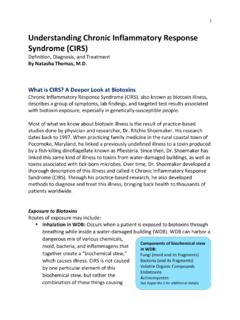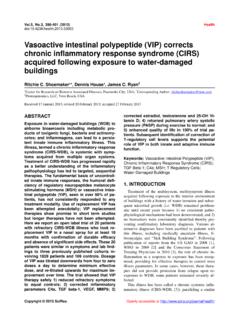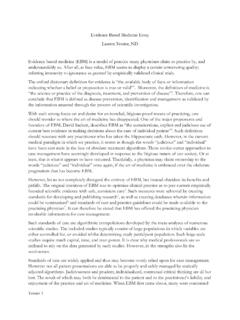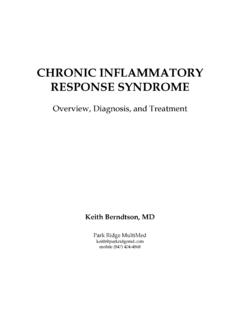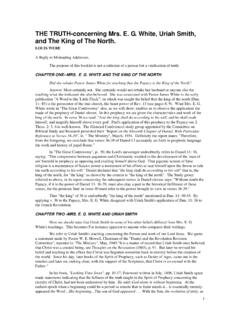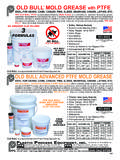Transcription of CHRONIC INFLAMMATORY RESPONSE SYNDROME
1 CHRONIC INFLAMMATORY RESPONSE SYNDROME Overview, Diagnosis, and Treatment Keith Berndtson, MD Park Ridge MultiMed mobile (847) 404-4868 2013 Keith Berndtson, MD 2 CHRONIC INFLAMMATORY RESPONSE SYNDROME Overview, Diagnosis, and Treatment This paper reviews a recently discovered CHRONIC biotoxin illness that affects as many as one in four people in the United States and elsewhere. Most of what we know about this condition is the result of practice-based studies done by physician-researcher Ritchie Shoemaker. In a series of studies going back to 1998, Shoemaker developed an increasingly thorough description of an illness caused by poor clearance of biotoxins produced by certain dinoflagellates, algae, and molds.
2 He named it CHRONIC INFLAMMATORY RESPONSE SYNDROME (CIRS), and he successfully developed methods to diagnose and treat it. Shoemaker speculates that the neuroimmune, vascular, and endocrine dynamics present in CIRS may play roles in other forms of CHRONIC illness including CHRONIC fatigue SYNDROME (CFS), fibromyalgia (FM), post-treatment Lyme SYNDROME (PTLS), and multiple sclerosis (MS). This paper summarizes Shoemaker s protocol for CIRS diagnosis and treatment. CIRS occurs when genetically susceptible people are exposed to certain biotoxins. This research dates back to 1997, when Ritchie Shoemaker, a family physician based in the rural coastal town of Pocomoke, Maryland, linked an illness to a toxin produced by a fish-killing dinoflagellate known as Since then, Shoemaker and others have linked the same kind of illness to toxins from molds commonly found in water-damaged buildings species of Stachybotris, Aspergillus, Penicillium, Chaetomium, Wallemia, and others2 and perhaps to toxins associated with tick-borne microbes (Borrelia, Babesia, Bartonella, Anaplasma, and Ehrlichia), though here the toxins involved have yet to be established by scientific consensus.
3 Other biotoxin producers include certain cyanobacteria (the freshwater blue-green algae Cylindrospermopsis and Microcystis, which can cause liver, neural, dermatological, and gastrointestinal complications), and a marine dinoflagellate that produces Ciguatera toxin, which moves up the ocean food chain into feeder fish and then to larger predator fish (such as red snapper, grouper, and barracuda)3 can also cause CIRS. When humans eat contaminated finfish, they can develop an acute ciguatera SYNDROME with severe gastrointestinal and neurological symptoms. In 1998, Shoemaker and Ken Hudnell were the first to link visual contrast deficits to Pfiesteria exposure.
4 In 2001, they were the first to link improvement in visual contrast sensitivity to the use of the cholesterol-binding resin, cholestyramine (CSM).,4 Hudnell has been a principal investigator for the U. S. Environmental Protection Agency s (EPA) National Health and Environmental Effects Research Lab and is an expert on how neurotoxins affect the physiology of vision. 2013 Keith Berndtson, MD 3 Shoemaker subsequently mapped out the pathways involved in CIRS and developed a case definition for the condition. The biotoxin-driven multisystem, multisymptom pathway imbalance persists until the culprit biotoxins are effectively cleared from the body and the neuroimmune, vascular, and endocrine imbalances are corrected (see Figure 1).
5 5 Among the sources of biotoxins that can produce CIRS, biotoxins from molds known to grow in water-damaged buildings (WDB) account for some 80% of the CIRS-related illness burden. In the case of mold toxins, recovery depends on continual effort to avoid re-exposure. Figure 1 While assembling an increasingly detailed understanding of CIRS disease mechanisms, Shoemaker and colleagues developed a stepwise protocol to treat them. Researchers in the fields of toxicology and environmental systems biology are beginning to show serious interest in CIRS and its implications for health care, ecology, industry, agriculture, and the economy. 2013 Keith Berndtson, MD 4 The CIRS Case Definition To warrant a diagnosis of CIRS, the following criteria should be met: 1.
6 History, signs, and symptoms consistent with biotoxin exposure. In cases of mold toxicity, history should include exposure to toxin-producing molds as documented by the EPA-approved ERMI test. In other cases (microcystin, ciguatera, etc.), history should include likely exposure or laboratory evidence of exposure. 2. A genetic predisposition to biotoxin-related illness based on identification of an HLA susceptible haplotype. 3. Abnormalities documented by Visual Contrast Sensitivity (VCS) testing. 4. Biomarkers consistent with the neuroimmune, vascular, and endocrine abnormalities that characterize CIRS. If you have a history consistent with biotoxin exposure, a susceptible genotype, and an abnormal VCS test, you are very likely to show the laboratory abnormalities seen in CIRS.
7 Major and minor criteria are a work in progress. CIRS Appears to Occur Only in the Genetically Predisposed Roughly 25% of the population is genetically prone to develop CIRS if exposed to sufficient amounts of biotoxin. An estimated 2% of the population have genes that render them highly susceptible to disabling symptoms from prolonged or recurrent exposure to biotoxins. Blood tests looking at HLA DRB and DQ haplotypes are used sort out the CIRS-susceptible patients from those who are not susceptible. Biotoxin exposure in HLA susceptible persons results in imbalanced responses between the innate and adaptive divisions of the immune system. The Innate Immune RESPONSE The innate immune system is factory installed and ready to go the minute you re born.
8 Cells equipped with pattern recognition receptors are ready and waiting to respond to the presence of unfriendly toxins produced by the living things that our ancestors encountered during the long course of evolution. These toxins are then processed (in ways that depend on HLA genetics) and presented to na ve lymphocytes called T cells, the lead organizers of the adaptive immune RESPONSE . The Adaptive Immune RESPONSE The newly exposed T cells then teach B cells how to recognize and respond to the most recognizable toxin parts. If again exposed to the same toxin, your B cells will produce antibodies to hunt them down. The Basic Problem in Patients with CIRS Though the exact mechanism of susceptibility remains unclear, patients prone to developing CIRS fail to mount an effective immune RESPONSE to biotoxins.
9 When this happens, the innate immune system shows signs of continuous but ineffective activation. 2013 Keith Berndtson, MD 5 The Most Common Signs and Symptoms Seen in Patients with CIRS Listed below are the most common of over 30 signs and symptoms that Shoemaker has documented in his patients suffering from exposure to biotoxins: Fatigue, weakness Post-exertional malaise Memory problems, difficulties with concentration and executive function Disorientation and confusion Headaches Vertigo, lightheadedness Muscle aches, cramping, joint pains without INFLAMMATORY arthritis Hypersensitivity to bright light, blurred vision, burning or red eyes, tearing Cough, asthma-like illness, shortness of breath, CHRONIC sinus congestion Air hunger or unusual shortness of breath at rest CHRONIC abdominal problems including nausea, cramping.
10 Secretory diarrhea A propensity to experience static shocks It takes more than a set of subjective symptoms and non-specific signs to separate CIRS from CFS, FM, or PTLS. Many patients with these diagnoses have a history and a set of biomarkers that are consistent with CIRS. Historical Patterns in CIRS Cases In cases that involve acute or CHRONIC onsets of multisymptom, multisystem illness with symptoms like those listed above, the cause could be exposure to: Worsening of multiple symptoms when in certain buildings or locations. If so, history should explore the various structures the patient has lived, worked, or gone to school in over the years to assess the likelihood of exposure to biotoxin-producing molds.

